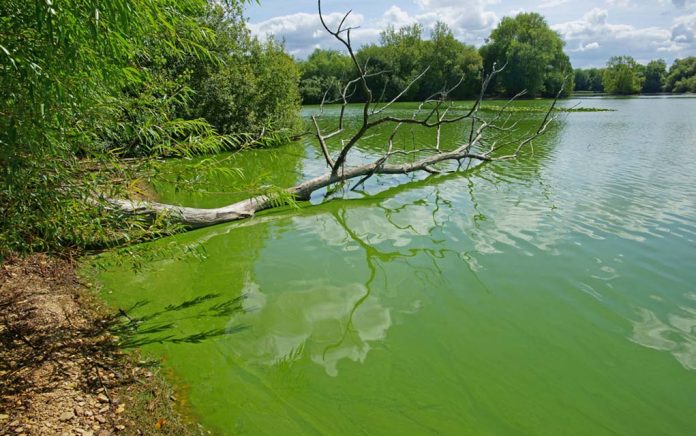
The Natural Danger Hidden in Plain Sight — It’s TOXIC!
(AscendHealthy.com) – Many of us live by lakes and other large bodies of water, which often double as recreational areas and warm-weather hot spots. Who doesn’t enjoy a day of play or a long walk along the lakeshore? In most cases, a swim in the local watering hole carries minimal risks, but if the water is infested with blue-green algae, it might quickly become toxic. Here are the dangers.
What Is Blue-Green Algae?
Not actually true algae, blue-green algae are cyanobacteria, a family of bacteria that behaves like both bacteria and algae. The Washington State Department of Health explains that these microbes thrive in warm, nutrient-rich water, which makes them most prominent during the summer and autumn months.
When they first appear, they may only cause a cloudiness to the water, but as they accumulate in numbers, they can form visible “blooms” that look like sheets of green or yellowish-brown paint. The surrounding water might also be green. Most types of blue-green algae aren’t toxic, but the few that are can pack a dangerous punch.
What Makes It Dangerous?
Some blue-green algae blooms emit toxins that can have serious effects on people and pets. The Pet Poison Hotline warns that these microbes are capable of creating two different types of toxins, microcystins and anatoxins. Microcystins are toxic to the liver, with consumption sometimes leading to full organ failure, whereas anatoxins attack the neurological system and are more likely to cause seizures and respiratory paralysis.
Health.vic recommends that pets and humans alike stay away from visible blooms. Some animals that consume contaminated water may have fatal responses. They don’t even have to drink any of it; grooming their fur after a quick swim can also cause toxin ingestion. Most humans experience severe and uncomfortable symptoms — vomiting, diarrhea, headache and fever — but usually survive. Skin contact may irritate as well, so make sure to remove contaminated clothing and rinse any exposed areas.
Staying Safe
Never drink potentially contaminated water, and keep pets and family members out of visible blooms. Don’t attempt to boil this water for home use; neither cyanobacteria nor their toxins will boil out. People who pump surface water into their homes should use bottled water when blooms are present.
According to the New York State Department of Health, fish living in contaminated waters may also pose a threat, with the toxins capable of building up in their bodies — especially in organ meat. Never fish in water where blue-green algae could be a problem. Always seek medical advice after possible exposure to cyanobacteria toxins.
Blue-green algae might look mundane enough, but depending on the bloom, it could be a powerhouse of toxin production. Avoid potential problems by steering clear of mucky, discolored water and using only clean, treated sources for food, drink and rinsing. If in doubt, consult a qualified lab to test for the bacteria and other dangerous contaminants.
~Here’s to Your Healthy Ascension
Copyright 2023, AscendHealthy.com




















